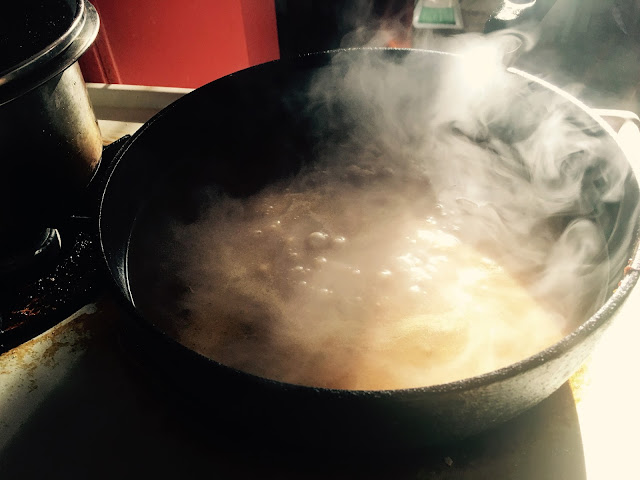When I am done with this meal you can have my life. It is heaven.
- Paul Prudhomme -
If cooking is in it's own way, a kind of religion, then Chef Paul Prudhomme would be my pastor (Sorry Phil!) For my father, it was Chef Justin Wilson. These great southern chefs were made available to us via public television and the internet and other media outlets, and the virtues of their approach to food and cooking resonated heavily with us. Perhaps it was because both were from what I consider to be one of the Meccas of food, Louisiana. I sincerely believe that in order to be a truly well rounded and SEASONED cook, one must not simply rely on having tasted foods cooked in the traditions and styles of the most influential food regions. I believe that taking a pilgrimage and traveling to these regions to sample the foods is irreplaceable. Hence the otherworldly success of travel/eating/culture shows like Anthony Bourdain's Parts Unknown and Andrew Zimmern's Bizarre Foods. My trips to Mexico have proven this theory to me.
The thing that drew me to casting my lot with Chef Paul was not just the beautiful dishes he'd create. But, his philosophy regarding flavor and particularly, seasoning. The man is reputed to have created the technique of blackening food, and he has some of the most popular seasoning blends that can be purchased pretty much everywhere. Chef took a simple approach to a sophisticated science. His mantra? "Season at every step." hit home with me, and has informed my cooking ever since. His predecessor, Justin Wilson did the same with my father and so as I learned from my father, he passed on what he took from Justin, to me.
Paul Prudhomme was my guy. So, like any good congregant, I took the opportunity to draw from the well of experiences and wisdom of my food pastor. I listened intently and applied through trial and error the lessons he taught. My first batch of seafood gumbo was the worst pot of goop I've ever tasted. My second attempt at sausage and chicken gumbo was a barely edible stew of some kind. My third pot was like a cross between some kind of maque choux and brunswick stew with bad smoked sausage, but it was the first one that I actually didn't mind eating. That fourth pot of gumbo changed everything though. Why? Well, in part because I'd learned what NOT to do when cooking and out of that process also came me standardizing our family's seasoning blend. We call it "The Basic Savory" blend. Here's how it looks.
 |
| Savory Blend |
Top Left: Seasoned Salt
Top Right: Garlic Powder
Bottom Left: Black Pepper
Bottom Right: Onion Powder
The Savory Spice Blend is pretty simple, but very good. There are a few things to take into consideration when using. First, if you want to combine the spices into a blend in one bottle, don't add the salt. Here's why. Salting and seasoning are two different things. When you go to use your spice blend, you don't want to add salt every time you decide you need to add more spice. Salt, as they say is a flavor engine, but it's also a balancing act determining how much to use or not. You don't want to end up with garlic/onion salt. And for goodness sakes, NEVER buy those horrible things. Always buy POWDER or GRANULATED versions of spices but never, never never the salt versions. So, if you're seasoning by sprinkling the spices individually then no worry. Just be careful not to ruin all of your hard work, not to mention great food by over salting it! Yes, I have done it and that's why I'm harping on it! Moving on.
From this basic blend we add or remove certain spices for each of our various dishes. Shrimp Nicole (our family Cajun Shrimp) foregoes the black pepper in exchange for Old Bay and paprika however; when we are frying fish, we add the Old Bay and paprika but remove the garlic and onion. It can be tricky! Also the way we address the ingredients with the spices can change for each dish. For frying chicken, we do a slurry or medium wet brine, taking out the black pepper in exchange for chili powder.
Many people's consideration of the Soul Food merits of a dish are actually based on how the food is seasoned as what determines whether it is or isn't official. Personally, I see seasoning as a part of the greater tapestry that absent or done badly lessens food of every kind....even if the right seasoning for a particular dish is no seasoning at all.
Enjoy,
Kev
From this basic blend we add or remove certain spices for each of our various dishes. Shrimp Nicole (our family Cajun Shrimp) foregoes the black pepper in exchange for Old Bay and paprika however; when we are frying fish, we add the Old Bay and paprika but remove the garlic and onion. It can be tricky! Also the way we address the ingredients with the spices can change for each dish. For frying chicken, we do a slurry or medium wet brine, taking out the black pepper in exchange for chili powder.
Many people's consideration of the Soul Food merits of a dish are actually based on how the food is seasoned as what determines whether it is or isn't official. Personally, I see seasoning as a part of the greater tapestry that absent or done badly lessens food of every kind....even if the right seasoning for a particular dish is no seasoning at all.
Enjoy,
Kev

















